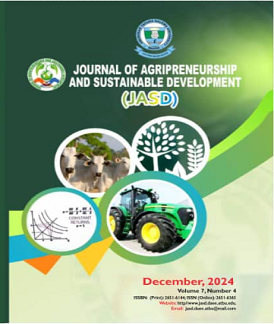MORPHOLOGY, CLASSIFICATION AND SUITABILITY EVALUATION OF SOILS FOR GROUNDNUT CULTIVATION IN OWERRI SOUTH EAST, NIGERIA
Keywords:
Classification, Evaluation, Groundnut, Morphology and SuitabilityAbstract
The study was conducted to characterise, classify and evaluate the suitability of soils in Ndegwu, Owerri area, Imo State, Nigeria for groundnut cultivation. Transects and soil angering were used to identify seven soil units. Seven (7) profile pits were dug each representing the soil units. The soils' morphological, physical and chemical properties reveal that percentage sand in all pedons was high with clay particles (54-90%) increasing with soil depth. The soil reaction was strongly acid to moderately acid (pH 4.70-5.80) and organic carbon (0.012.10%). Total nitrogen (0.01-1.20%); CEC (4.00-33.00 cmolkg-1) and exchangeable K (0.041.00 cmolkg-1) were rated very low to high. Percentage base saturation was low to high (30.30-60.90%); Available P was low to moderate (4.50-16.50mgkg-1); Exchangeable Mg was very low to high (0.01-2.00 cmolkg-1). Exchangeable Na was low to moderate (0.020.0.04 cmolkg-1); Available Mn ranged from 1.70-5.50mgkg-1 in all the pedons analysed. Available Fe ranged from 2.33-6.80 mgkg-1; Available Cu ranged from 0.4-2.15mgkg-1, Available Zn ranged from 1.50-6.75mgkg-1 which were all above their critical limits [1.0 mgkg-1(Mn), 2.0mgkg-1 (Fe), 0.4mgkg-1(Cu) and 2.0mgkg-1 (Zn)]. Soil units ON-01, 02, 03 and 07 were classified as Typic Hapludult at the sub-group level or Haplic Acrisol (WRB). Soil units ON-04 were classified as Oxic Dystrudent at the subgroup level or Haplic Arenosol (WRB) while soil units ON-05 and 06 were classified as Typic Paleudult at the subgroup level (USDA) and Haplic Acrisol (WRB). Results of the Land suitability evaluation (LSE) classified the soils as currently unsuitable (N1-f) with fertility (Organic carbon, Total N and Base saturation) as a limitation. Agronomic and soil management practices such as liming, organic manuring, avoidance of bush burning and crop rotation could also make these soils highly suitable for groundnut cultivation.
Downloads
Downloads
Published
How to Cite
Issue
Section
License
Copyright (c) 2025 Journal of Agripreneurship and Sustainable Development

This work is licensed under a Creative Commons Attribution 4.0 International License.



